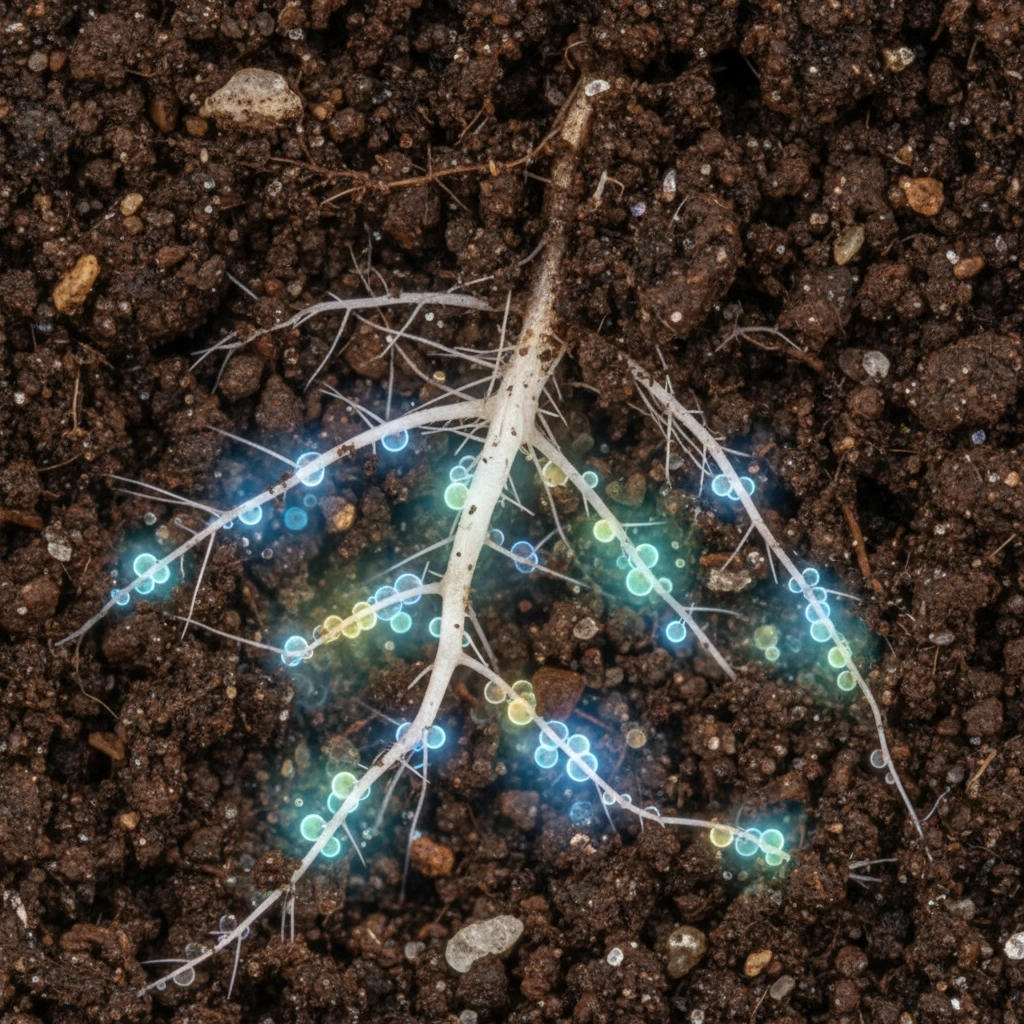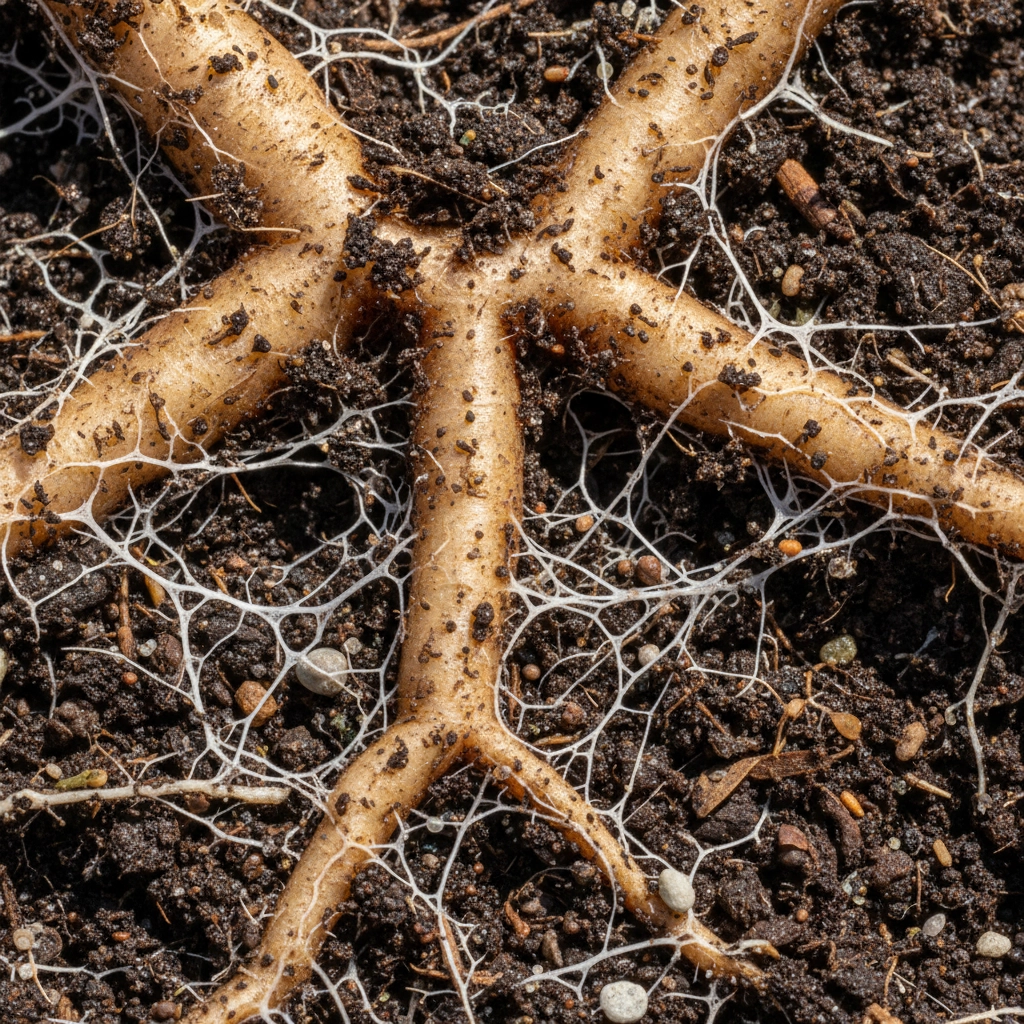Blog
Root Exudates 101: How Your Plants Talk to Microbes for Nutrient Boosts
Your plants are having conversations right beneath your feet, and you probably don't even know it. Through an intricate chemical communication system, plant roots continuously release compounds that attract beneficial microbes, negotiate nutrient deals, and create thriving underground partnerships. These secretions, called root exudates, represent one of nature's most sophisticated biological networks, and understanding how they work can revolutionize your growing success.
Root exudates are fluids and organic compounds that plants emit through their roots, fundamentally shaping the soil ecosystem around them. Think of them as a plant's way of "talking" to the microbial world, recruiting beneficial organisms while deterring harmful ones. This underground dialogue is so important that plants invest between 5% to 21% of all their photosynthetically fixed carbon into producing these chemical messengers.
What's Actually in Root Exudates?
The composition of root exudates reads like a molecular feast for soil microbes. These secretions contain sugars, amino acids, organic acids, vitamins, phenolic compounds, terpenoids, steroids, and various high molecular weight polymers. Soil microbiologists have described this mixture as plants essentially "dumping cakes and cookies" onto their root surfaces to feed beneficial organisms.

Root exudates fall into three main categories based on molecular weight. Low molecular weight compounds include simple sugars and amino acids that provide immediate energy for microbes. High molecular weight compounds encompass mucilage and polysaccharides that create protective barriers and support longer-term microbial communities. The third category includes various ions that help regulate soil chemistry and nutrient availability.
The specific composition varies dramatically depending on plant species, developmental stage, and environmental conditions. Young plants might secrete mostly sugars during early growth, while mature plants shift toward predominantly amino acids and phenolic compounds. This dynamic adjustment allows plants to attract different microbial partners as their nutritional requirements evolve throughout their lifecycle.
The Underground Communication Network
Plants don't just randomly dump compounds into the soil, they actively manage their exudate profiles to recruit specific microbial partners based on their current needs. This sophisticated system works both ways: root exudates serve as nutrient sources that support microbial growth while simultaneously acting as signaling molecules that influence bacterial behavior, movement, and colonization patterns.
When plants experience stress, they can release specific "cry-for-help" compounds that recruit protective microbes capable of defending against pathogens. Laboratory experiments have demonstrated the precision of this recruitment system. When researchers applied root exudates from one plant species to soil without any living plants present, the resulting microbial community closely resembled what naturally develops around that plant's roots.
The communication extends beyond simple attraction. Beneficial microbes respond to these chemical signals by producing their own compounds that enhance plant health, create protective biofilms, and even trigger improved stress resistance in their plant partners. This creates a feedback loop where plants and microbes continuously adjust their chemical outputs based on environmental conditions and mutual needs.
Nutrient Mobilization Through Microbial Partnerships
Root exudates enhance nutrient availability through multiple interconnected mechanisms. Plants release organic acids that acidify surrounding soil and chelate nutrients, effectively unlocking minerals that would otherwise remain bound to soil particles. These organic acids can bind directly to soil minerals, making them crucial regulators of both nutrient mobilization and carbon cycling.

The recruited microbes reciprocate by colonizing root surfaces and providing tangible benefits to their plant hosts. Beneficial bacteria enhance uptake of essential elements like phosphorus and nitrogen while protecting roots from disease-causing organisms. Mycorrhizae for plants represent one of the most important partnerships in this system, these beneficial fungi extend root networks exponentially, accessing nutrients from much larger soil volumes than roots could reach alone.
Plants can even reclaim their exudates when resources become scarce. Studies using radio-labeled carbon have shown that plants growing under nutrient-deficient conditions will reabsorb their own root exudates to prevent wasting precious energy. This demonstrates the calculated nature of these chemical investments.
The Rhizosphere: Nature's Most Active Real Estate
The zone of soil immediately surrounding plant roots, called the rhizosphere, becomes what scientists describe as an "ecosystem hotspot" due to concentrated activity driven by root exudates. This area typically extends just a few millimeters from root surfaces but contains microbial populations that can be 10 to 100 times more abundant than bulk soil.
Root exudates serve as the essential carrier for material cycling, energy exchange, and information transfer between plants and soil organisms. Through this system, plants can inhibit harmful microbes while simultaneously promoting beneficial organisms and even supporting neighboring plants of the same species, a form of chemical cooperation that challenges traditional ideas about plant competition.
The rhizosphere ecosystem functions as a biological marketplace where plants trade carbon-rich compounds for improved nutrient access, disease protection, and stress tolerance. The most successful plants are those that manage this marketplace most effectively, attracting diverse microbial communities that provide multiple services simultaneously.
Enhancing Root Exudate Systems in Your Garden
Understanding root exudate science opens up practical opportunities to optimize plant health through microbial inoculant applications and soil management strategies. Products like Mykos mycorrhizae inoculant work by introducing beneficial fungi that integrate directly with plant root exudate systems.
These mycorrhizal fungi form symbiotic relationships with plant roots, extending the effective root zone and enhancing the plant's ability to communicate with soil microbes. When you inoculate your plants with quality mycorrhizae products, you're essentially jumpstarting the underground communication network that might otherwise take weeks or months to establish naturally.
The key is providing diverse microbial communities that can respond to your plants' chemical signals. Healthy soil biology creates a positive feedback loop, plants with access to beneficial microbes produce more diverse root exudates, which attract even more beneficial organisms, leading to improved nutrient cycling and plant performance.
Optimizing Growing Conditions for Root Communication
Several factors influence the effectiveness of root exudate systems in your growing environment. Soil pH affects both the composition of root exudates and the activity of soil microbes that respond to them. Most beneficial microbial activity occurs in slightly acidic to neutral conditions, typically between pH 6.0 and 7.0.
Organic matter content plays a crucial role by providing habitat and food sources for beneficial microbes beyond what root exudates alone can supply. Compost, aged manure, and other organic amendments create the foundation for thriving microbial communities that can effectively partner with your plants.
Water management also affects root exudate production and microbial activity. Consistent moisture levels support steady communication between plants and microbes, while drought stress can alter exudate composition and reduce beneficial microbial populations.
Temperature influences both root exudate production rates and microbial activity. Most beneficial soil microbes are most active in moderate temperatures, typically between 60-80°F, which corresponds with optimal growing conditions for most plants.
The Science Behind Successful Growing
Root exudate research reveals why some growing methods work better than others. No-till gardening preserves established microbial networks that have developed around plant roots. Cover cropping maintains active root exudate production even when primary crops aren't growing, feeding beneficial microbes year-round.
Diverse plantings create more diverse root exudate profiles, which support broader microbial communities and more resilient soil ecosystems. Monocultures, while sometimes necessary for production efficiency, limit the chemical diversity that drives microbial partnership formation.
Understanding these principles helps explain why healthy soil biology leads to reduced fertilizer requirements, improved disease resistance, and better stress tolerance. Plants with strong microbial partnerships simply perform better across all growing conditions.
This underground chemical dialogue represents one of nature's most elegant examples of interspecies cooperation, where plants leverage their photosynthetic ability to create a thriving microbial workforce that dramatically improves their nutritional status and overall fitness. By supporting these natural processes through appropriate soil management and microbial inoculation, you're working with billions of years of evolutionary refinement to optimize your growing success.
